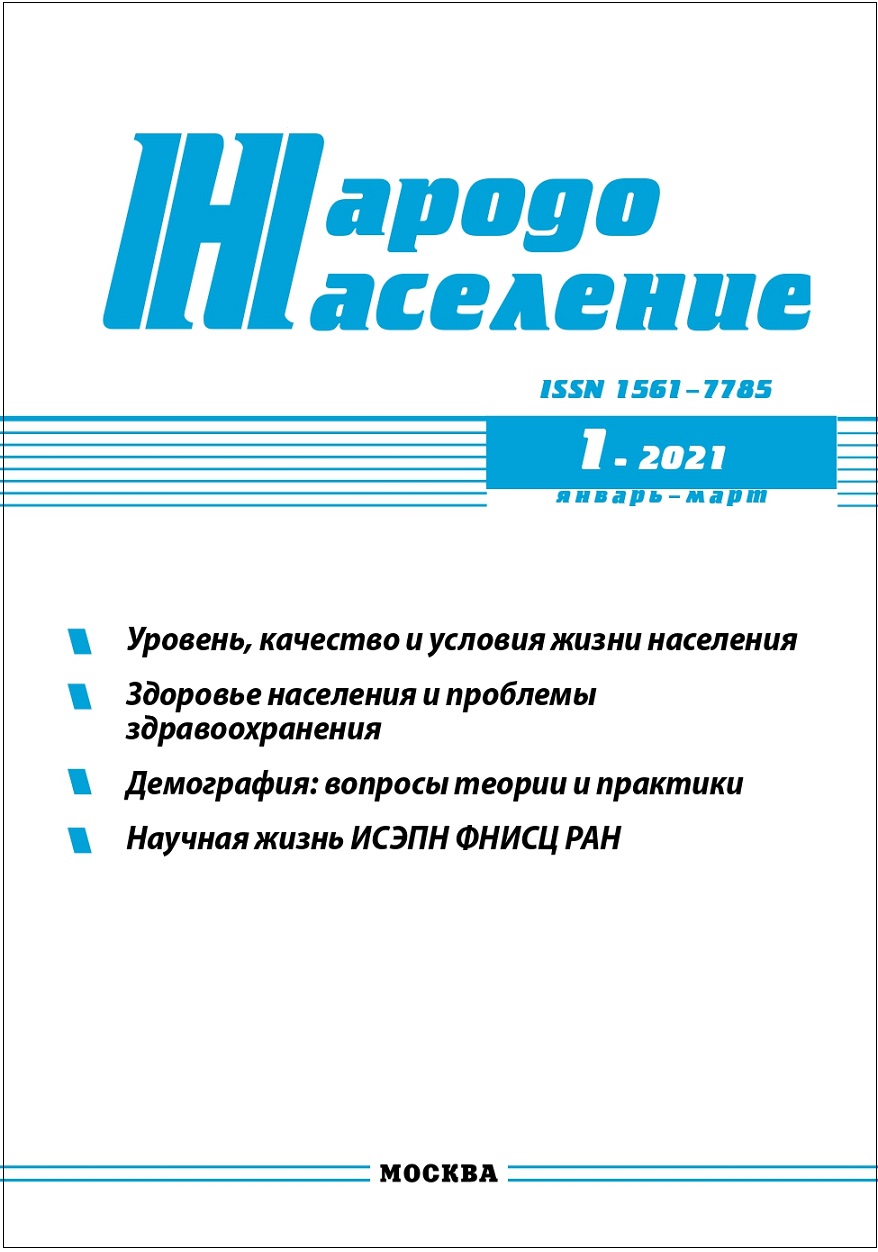Impact of urban environment quality on the demographic indicators of population health
Research Article
Acknowledgments
The study was carried out with the financial support of RFBR, project No. 18-013-00508_a.
How to Cite
Budilova E.V., Lagutin M.B., Migranova L.A. Impact of urban environment quality on the demographic indicators of population health. Population. 2021. Vol. 24. No. 1. P. 44-53. DOI: https://doi.org/10.19181/population.2021.24.1.5 (in Russ.).
Abstract
The article was prepared on the results of a study of the impact of urban environment quality (UEQ) on the demographic characteristics of city dwellers (birth and death rates, ageing index, birth-death ratio). These demographic indicators, in the authors' opinion, can reflect to a certain extent the state of population health. More comprehensive data on the Russian urban population health (life expectancy at birth, primary disease incidence by main disease classes, disability, etc.) are not published by Rosstat. This article is the first to set the task of assessing the impact of urban environment quality on city dwellers health through the urban environment quality index developed by specialists from the RF Ministry of Construction and other organizations in 2018. The study was carried out in 174 cities of the Russian Federation with a population of over 100 thousand people. The cities were grouped according to the following criteria: UEQ index, population size, belonging to Federal Districts. The strength of relationship was estimated by Spearmen rank correlation coefficient, the reliability of the obtained results was checked by scatterplot and Pearson correlation coefficient. Comparison of the city groups was made using nonparametric analysis of variance. To check the differences between the groups of cities, the Kruskal-Wallis test by ranks was implemented.
Keywords:
demographic indicators, population health, urban environment quality (UEQ) index, correlations, types of cities by population size and UEQ index
References
1. Budilova E. V., Lagutin M. B., Migranova L. A. Dinamika populyatsionnogo zdorov'ya naseleniya Rossii v 2005-2016 gg. [Dynamics of population health in Russia in 2005-2016]. Narodonaselenie. [Population]. 2018. Vol. 21. No. 2. Р. 99-109. DOI: 10.26653/1561-7785-2018-21. (in Russ.)
2. Budilova E. V., Lagutin M. B., Migranova L. A. Vliyaniye demograficheskikh i sotsial'no-ekonomicheskikh faktorov na populyatsionnoye zdorov'ye naseleniya [Impact of the demographic and socio-economic factors on the population health]. Narodonaselenie. [Population]. 2019. Vol. 22. No. 3. P. 80-92. DOI: 10.24411/1561-7785-2019-00028. (in Russ.)
3. L'vova S. Minstroy Rossii obnarodoval pervyy v strane indeks kachestva gorodskoy sredy [RF Ministry of Construction has published the first urban environment quality index in Russia]. Available at: https://strategy24.ru/rf/news/minstroy-rossii-obnarodoval-pervyy-v-strane-indeks-kachestva-gorodskoy-sredy (Accessed: 5 September 2020). (in Russ.)
2. Budilova E. V., Lagutin M. B., Migranova L. A. Vliyaniye demograficheskikh i sotsial'no-ekonomicheskikh faktorov na populyatsionnoye zdorov'ye naseleniya [Impact of the demographic and socio-economic factors on the population health]. Narodonaselenie. [Population]. 2019. Vol. 22. No. 3. P. 80-92. DOI: 10.24411/1561-7785-2019-00028. (in Russ.)
3. L'vova S. Minstroy Rossii obnarodoval pervyy v strane indeks kachestva gorodskoy sredy [RF Ministry of Construction has published the first urban environment quality index in Russia]. Available at: https://strategy24.ru/rf/news/minstroy-rossii-obnarodoval-pervyy-v-strane-indeks-kachestva-gorodskoy-sredy (Accessed: 5 September 2020). (in Russ.)
Article
Received: 15.10.2020
Accepted: 22.03.2021
Citation Formats
Other cite formats:
APA
Budilova, E. V., Lagutin, M. B., & Migranova, L. A. (2021). Impact of urban environment quality on the demographic indicators of population health. Population, 24(1), 44-53. https://doi.org/10.19181/population.2021.24.1.5
Section
ESTIMATION OF POVERTY AND WAYS TO ITS REDUCTION








